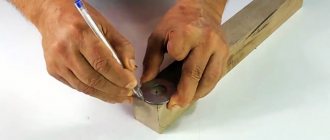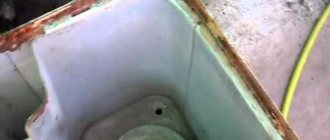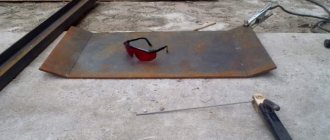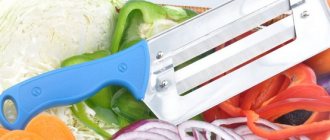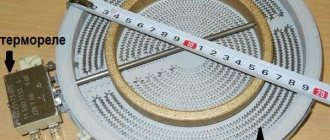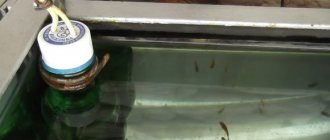During the fruit and vegetable season, owners of gardens and vegetable gardens often prepare home-made juice. This drink is rich in vitamins and microelements, which has a positive effect on the human body. In addition, producing juice yourself is comparatively cheaper than buying it at the supermarket. The modern market for home appliances offers a wide range of juicers, but such equipment is expensive and not always of good quality. That is why connoisseurs of homemade juice are looking for options for creating a juice press on their own and from scrap materials.
DIY juicer.
Operating principle of juice extraction devices
It is possible to create a highly functional apparatus for making nectar only by understanding the principle of its operation. Juice from fruits, vegetables or berries is obtained by applying powerful pressure to them. Moreover, some devices first crush the raw materials and then squeeze out the juice, while others immediately press them.
Most often, mechanical juicers are constructed at home. They are easy to assemble, but at the same time have fairly high productivity for household use. The operating principle of such devices is based on the fact that the processed products are affected by a piston, the pressure on which occurs due to a screw mechanism. Vegetables, fruits and berries are placed in a special perforated basket, through which the finished juice flows into a storage container.
The basket of screw presses is usually made of stainless steel sheet or hardwood. Wooden baskets are drainage grates that consist of two elements connected to each other using metal hoops. The screw presses of this unit are so powerful that they are even used to obtain nectar from apples or pears. However, the raw materials loaded into the basket of such a juicer should only be finely chopped.
Scheme of a homemade juicer.
Components of the Bosch MES series juicer
Fortunately for owners of this type of device from this well-known manufacturer, it will be necessary to disassemble the electrical device for repair in very rare cases. Another thing is the everyday disassembly after squeezing the juice, which any housewife or owner should learn to do quickly and even automatically.
By the way, this will be the case with models of the Bosch MES series: the first time you may need to look through the instructions to do everything correctly. But then cleaning and washing the juicer will take place quickly and almost “on autopilot”.
Before starting work, carefully inspect the device. It roughly consists of the following parts:
- switch with three positions: open - intended to unlock the lid; off — off state; on or 1—on state;
- the electric motor block, which provides a compartment for the cord from the power supply - depending on the model, it is made of plastic (most often) or stainless steel;
- container where product waste (cake) is collected - made mainly of plastic of various shades;
- a strainer made of stainless steel, less often - made of plastic;
- insert for a plastic strainer to match the color of the body;
- cover with a shade of the main color of the model;
- loading insert made of transparent polymer;
- transparent plastic pusher;
- container for storing finished juice, equal to one liter, with a special compartment for foam, made of transparent plastic to match the color of the body;
- legs made of food-safe rubber.
Types of juicers
Juicers can be different both in power and in design. There are two large groups: manual and electrical appliances.
The first type is mechanisms with a simple principle of operation, which are mainly suitable for raw materials such as citrus fruits, apricots, grapes and soft vegetables (tomatoes). The equipment power is no more than 0.2 kW/h.
The second type is characterized by the presence of a powerful engine that drives the grater. It is designed for chopping fruits, vegetables or berries. Using centrifugal force and a separation mesh, the juice is poured through a special channel into a container for collecting liquid, and the pulp is sifted out through a hard filter. The resulting cake ends up in a hopper and is then cleaned by hand.
Electric juicers are divided into the following types:
- household, which is intended for use at home;
- a professional juice press has advanced technical capabilities and is used, as a rule, in catering establishments;
- the industrial apparatus is capable of producing large volumes of vegetable, fruit and berry juice. Such equipment is used in enterprises specializing in the processing of fruits, vegetables and berries.
DIY homemade juicer.
In addition to the listed types, juicers are divided into universal and citrus. Based on the name, it becomes clear that the first type is designed to work with a variety of raw materials to obtain juice, and the second is used only for citrus fruits and soft-textured vegetables.
There are several more characteristics of the separation of juice making machines:
- Centrifugal juicer. The design of such a device is a container with a sharp knife, which grinds raw materials at high speed. Due to centrifugal force, the pieces are pressed against the walls, and liquid is released from them, which flows into the glass, and the remaining cake remains on the filter. When choosing a centrifugal juicer, it is better to pay attention to a product with a conical separator. This option automatically removes the pulp into a special container, so the remaining raw materials do not interfere with the juicing process. In a juicer with a cylindrical separator, vegetable and fruit waste remains inside the container, which interferes with both juice separation and further cleaning of the equipment.
- Screw juicers work on the principle of grinding raw materials and squeezing juice out of them. The fruits for such a device do not need to be chopped, but placed in their entirety. The designs are divided into low-power - single-screw and high-power - twin-screw.
- Press for squeezing juice. The process of obtaining the drink involves high-power pressure on the raw materials. This method is considered the most effective.
According to the system of loading products and supplying juice, juicers are divided into devices with direct feeding and devices with juice supply into the internal storage.
Homemade juicer from a horizontal loading washing machine
Having an old, non-working automatic washing machine allows you to make a centrifugal juicer with little effort. The user of household appliances is aware of the various operating modes of the machine when performing tasks when washing and spinning clothes. It is the latter function, or rather, its restoration that will now allow you to squeeze out juice from fruits and vegetables, rather than squeezing out laundry. To implement this plan it is necessary:
- Make sure the drum is intact and the electric motor is working properly.
- Disassemble the machine, remove the drum, wash, clean all internal surfaces of the unit, especially the rubber sealing elements. If necessary, clean rusty surfaces and scale with sandpaper.
- Using a tester, determine whether the electric motor can operate in spin mode, and if a tester is not available, find the wire for direct activation of the motor at maximum speed. Install a switch in the open circuit found.
- Remove the filter and drain pump. Replace the drain hose with a new one or ideally clean the old one. The drain should be equipped with a ball valve to regulate and control the flow of juice.
- Close, rivet, and weld all channels and holes inside the machine that are not needed for draining juice, except for the water supply hole (it is used for washing equipment after spinning). Dismantle the heating element. Clean the sealed cavities and check for tightness.
- Place the drum in its original place, secure it and tilt the machine so that the horizontal loading cover is at the top.
- To check the functionality and tightness of sealing of all cavities inside the body, water is forced into the machine and left for 10–15 minutes, after closing the drain valve. If there are no leaks, the unit is turned on and the drain valve is opened.
ATTENTION! The presence of small leaks during inspection is not a reason for mandatory repair. By weighing the importance of the location of the leak, the user himself determines the need to repair the detected problem.
After checking, the unit can be loaded with fruit, squeezed out the juice and preserved for the winter.
What is an apple press?
In a year fruitful for apples, the issue of fruit processing becomes acute. In addition to compote, jam and marmalade, you can make apple juice.
There are different types of apple presses:
- the most popular is a mechanical press;
- hydraulic, made, for example, from a jack;
- The combined press combines both a jack and a screw mechanism.
The disadvantages of using a press include the following facts:
- the need for great physical strength;
- a homemade juicer is bulky and requires a lot of storage space;
- labor-intensive care after use.
To make the juice tasty, aromatic, and most importantly, healthy, the following requirements for preparing fruits for crushing should be met:
- Careful sorting, cleaning and drying of fruits before loading into the device.
- To make the work easier, the fruits can be cut in half.
- The taste of the drink is spoiled by spoiled, rotten fruits.
It is quite possible to make an apple press yourself. To do this you should prepare:
- stainless steel sheet;
- channel or square metal pipe with a cross section of 4x4 centimeters and a wall of 3 mm thickness;
- pipe with a diameter of 1.6 cm;
- rod with thread on the surface;
- screw;
- board 3 cm thick;
- welding machine;
- grinder and electric drill;
- hammer;
- hacksaw for metal.
Press for squeezing juice from apples.
When starting to assemble an apple press, you need to prepare a drawing or schematic drawing.
Further construction will proceed according to the following scheme:
- Making a perforated basket from a stainless steel sheet into which the raw materials for pressing will be loaded. The sheet is perforated in advance, and then a cylinder is formed and the seam is secured by welding. To prevent juice from spilling out of the holes, a protective casing is made. It is prepared in the same way as the basket - from a stainless steel sheet, only with a larger diameter.
- Construction of the bed.
- Construction of legs for structural stability.
- A hole is drilled in the upper part of the resulting press frame into which a nut for the screw mechanism is welded. A wood board can be used as a piston through which the screw mechanism will exert pressure on the raw materials loaded into the basket (a circle of the appropriate diameter is cut out of it).
- Welding the handle to the screw rod, through which it can be rotated, and installing the basket and protective casing on the storage tray.
The apple press is ready for use.
Tips for work
After creating an apple juicer with your own hands, an equally important stage begins - fruit processing. Harvesting and preparing the fruit for it takes time.
For the assembled device to operate effectively, the following sequence of actions must be followed:
- The apples are carefully sorted, washed and dried to remove excess moisture.
- Large fruits are cut into smaller pieces. The core should be removed.
- Rotten parts of the fruit are thrown away. Otherwise, they will spoil the taste of the finished drink.
- The chopped fruits are placed in the working basket of the unit. The smaller the pieces, the easier it will be to squeeze out the juice.
- They put the mechanism into action.
After the juice extraction process is completed, dry pulp remains. It can be used as livestock feed or left to ferment. Don't be alarmed if the drink contains pulp. In this case, the juice should be allowed to brew. After this, it is filtered and boiled.
A DIY juicer is a useful invention. With its help, you can bring your engineering ideas to life and save money. The device will last for many years, allowing you to preserve all the beneficial substances contained in apples.
How to make a juicer with your own hands
An excellent alternative to buying a juicer is a homemade machine. Craftsmen advise using ingenuity and creativity, then the resulting device will delight your household with a tasty and aromatic juice that is healthy for the whole family.
From a horizontal loading washing machine
A functional juicer can be made from various household appliances, for example, from a washing machine. The juice is obtained by operating the spin mode, so the performance of the equipment is an important condition for a positive result.
The design of a juicer from a washing machine.
How to make a juicer with your own hands:
- Checking the motor and drum of the washing machine for integrity and performance.
- Removing the drum from the equipment body.
- Thorough washing of the device, removing scale and rust, cleaning the drain hose.
- Mounting in the wire responsible for the operation of the motor at high speeds of the switch.
- Removing the drain pump and filter.
- Installing a ball valve on the drain.
- Sealing the device.
- Assembling the equipment in its original state and installing the machine so that it is possible to load raw materials from above.
- Design testing.
The washing machine juicer is ready to use.
From a mortar mixer
You can use a stand mixer to chop fruits and vegetables. To do this, you need to equip its lower part with several bolts.
The products are crushed in a metal bucket, in the body of which holes are made for the outflow of juice.
To increase the performance of this design, the number of revolutions should be increased. This can be done by attaching the mixer to a drill. To achieve the maximum amount of drink, the crushed raw materials are sent under a press.
From a meat grinder
An ordinary manual meat grinder makes an excellent device for extracting juice. But this method is impossible without a special nozzle for collecting liquid when grinding raw materials.
A juicer made from a meat grinder.
Most often it comes complete with a standard meat grinder, but it is possible to purchase it separately in specialized hardware stores.
A meat grinder juicer differs from the listed designs in its ease of assembly and the elementary nature of the juice production process. It does not require electricity or much physical strength.
From the jack
You can make a powerful press from a 3-ton car jack. The advantage of the press is that it does not require much physical force to obtain the drink, but assembling the installation will require some effort. The design of the juicer is equipped with a frame that can withstand high pressure. The jack can be installed both from above and from below.
Washing machine drum press
From a washing machine you can make not only a juicer, but also a press, using separate parts from it. The design is quite simple since there is no electric motor, no electricity required, and no complex structural components. For the washing machine, we only need a centrifuge made of stainless steel. Since the part has holes, this allows it to be used for the purposes in question. The manufacturing process consists of the following steps:
How to care for your home crusher
Caring for equipment is a prerequisite for its operation. Only with high-quality and careful care will household appliances serve with maximum functionality for a long time.
Juicers are no exception, because the remaining pulp of fruits and vegetables will become a huge breeding ground for bacteria and mold. In addition, the cake forms a coating on the body, contributing to the destruction of parts.
When caring for your home crusher, you should adhere to the following principles:
- Disassembling the device after use.
- Thorough rinsing and cleaning.
- Drying parts.
- Storage unassembled in a specially designated place.
Procedure for disassembling the juicer
In the household appliances market, as elsewhere, there are favorites and outsiders. The Bosch company and its series of juicers called Bosch MES have been deservedly popular for several years. The main feature is a long service life without breakdowns and excellent price-quality ratio.
But, unfortunately, when malfunctions occur, many buyers become interested in how to disassemble this juicer. After all, it is clear that by carrying out repairs yourself, you will save money. Moreover, difficulties can arise only during the first disassembly, and then, usually, everything turns out easily and quickly.
And the breakdown is not always serious enough to call in specialists. Often this is some kind of “trifle” that any man can easily cope with. And even more so if the household appliance simply needs to be disassembled after its intended use.
Equipment and sequence of actions
To make a homemade centrifugal juicer, we need an old washing machine (necessarily with a working centrifuge).
The resulting semi-automatic device will perform a number of tasks:
- grind raw materials;
- squeeze and filter juice;
- wash the internal installation yourself.
A mandatory requirement for the selected washing machine model is an existing activator at the bottom of the tank. Old samples that have serviceable parts are also suitable for use.
To make your work easier, first of all you need to draw detailed drawings: make a detailed layout of the future juicer. Then you should prepare all the tools.
In the process we will need the following elements:
- centrifuge;
- serviceable casing;
- brackets for fastenings;
- bearings of different sizes.
Selected elements should be cleaned from regular exposure to powder - rust and scale. To do this, use fine sandpaper to polish all surfaces to a shine.
The next steps are making the grater and gasket. To do this we need a cutting tool, for example, a grinder. It is better to cut the gasket from stainless steel to increase the durability of the entire device.
From an activator type machine
A centrifugal juicer can also be made from an activator-type washing machine. The activator and shaft are removed from the bottom of the tank, and a shaft of the required diameter is installed. Three knives are installed on the shaft thread with nuts at an angle of 60 degrees. The drain hole closes. A stainless steel mesh with a mesh size of approximately 1.5 mm is placed on the wall of the centrifuge with an overlap of 40-50 mm. A complete rubber cap, plugged with a stopper, is placed on the bottom. Everything is washed with baking soda. The timer relay is turned off or its toggle switch is jammed.
Several apples are dropped into the tank onto moving knives. The fruits are crushed for 20-30 minutes. At a time, transfer no more than 3 liters of the resulting puree into the centrifuge so that it does not spill out. After 2-3 minutes, the mesh containing the waste is removed.
The assembled apparatus prepares 10-12 liters of juice with pulp per hour and works with juicy fruits. To remove sediment, the juice is allowed to settle and then passed through cheesecloth.
What you shouldn't forget
An important nuance is the modification of the drum. This part should be equipped with additional stiffeners and a filter mesh. To make a bunker for apples and other raw materials, you will need a polyethylene pipe . Use metal corners to secure it. The pipe should be screwed with a slight deviation from the center so that its edge is “at the exit” of the grater.
Any wooden cutting can be used to make a pusher for tomatoes and other fruits. Don't forget to put a limiter so that the device does not sag or sink to the grater.
To make a high-performance squeezer, you will definitely need a powerful engine. It is important to secure all parts well and insulate electrical parts.
Disassembling the juicer: step-by-step instructions
Lovers of freshly squeezed juice and happy owners of devices for squeezing it inevitably face the problem of how to disassemble their favorite juicer without fatal consequences for its functionality. There are many such household appliances available in the market under different brands.
They can be made in four options:
- centrifugal type,
- with screw extraction,
- combined,
- devices for citrus fruits.
Features of disassembling Bosch MES juicers
Please note that in the case - where the engine block is located - there is a special compartment for storing the power cord. This is quite convenient when disassembling and operating, as you save a lot of free working space.
Although, in order to take advantage of the hidden "pocket", the electrical cable will have to be inserted and pulled out manually. There is no “auto-finishing” mechanism, as, for example, in vacuum cleaners. The engine block itself can be easily removed without any problems.
The shutdown button (lever) has three positions: On, Off and unlocking the lid. But the main thing is that it helps to unfasten the lid when it’s time for washing or routine cleaning.
The functionality of this approach is excellent, but the main thing is that this lever serves you for a long time. You will use it very often, which leads to accelerated wear of the part.
Also note that when you move the power lever to the position that opens the lid, it does not swing upward all the way. It’s just that a gap appears between it and the body, allowing you to open it completely with your own hands. If necessary, remove the cover very carefully so as not to damage the internal fasteners.
The container for collecting cake is quite large in size and can be easily removed from the housing. These features allow you to use the juicer to prepare drinks for a family of several people. By the way, washing the pulp container is convenient thanks to its well-designed shape.
The plastic insert for attaching the strainer can also be removed quickly and conveniently. You need to pull the edge on the side of the container for collecting pulp with one hand, and with the other hand, gently push the tap designed to drain the juice into the container.
The strainer is most often made of high-quality stainless steel and there are no problems with removing it from the body. If in your model it turns out to be plastic, it doesn’t matter, the characteristics will remain virtually unchanged.




